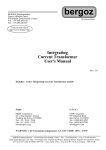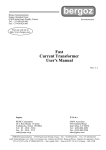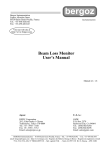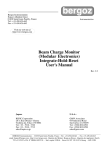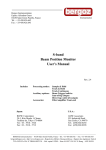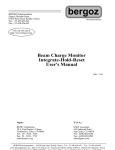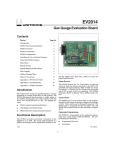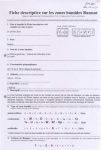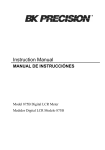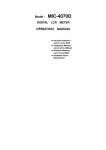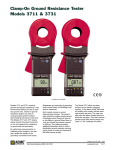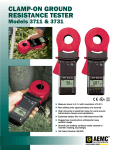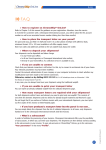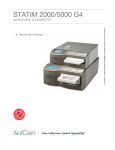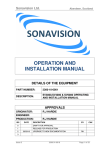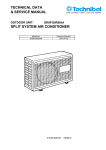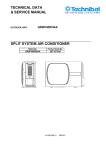Download ACCT manual 2-1 - GMW Associates
Transcript
bergoz Bergoz Instrumentation Espace Allondon Ouest 01630 Saint Genis Pouilly, France Tel.: +33-450.426.642 Fax: +33-450.426.643 Instrumentation A.C. Current Transformer User's Manual Rev. 2.1 WARNING ! Do NOT heat sensor beyond 80°C / 176°F ACCT Electronics are NOT protected against power supply polarity inversion Japan: U.S.A.: REPIC Corporation 28-3, Kita Otsuka 1-Chome Toshima-ku, Tokyo 170-0004 Tel.: 03 - 3918 - 5326 Fax: 03 - 3918 - 5712 [email protected] GMW Associates 955 Industrial Road San Carlos, CA 94070 Tel.: (650) 802-8292 Fax: (650) 802-8298 [email protected] BERGOZ Instrumentation - 01630 Saint Genis Pouilly, France - Tel.: +33-450.426.642 - Fax: +33-450.426.643 email: [email protected] - http://www.bergoz.com - Registre des Métiers: Bourg-en-Bresse - Registre des ingénieurs: Zurich TVA-VAT-IVA-USt. Nº FR88414997130 - Sàrl. capital 152K! - Siren 414 997 130 R.C.S. Bourg - APE 332B Record of updates Version Release date 2.1 June 5, 2008 p.3 General Description: Parts numbers Reference to new High-resolution and Wideband versions Output polarity: Examples p.7 Specifications. High-resolution version specifications Wideband version specifications. BERGOZ Instrumentation 01630 Saint Genis Pouilly, France Tel. +33 - 450.426.642 Fax +33 - 450.426.643 A.C.Current Transformer User's manual SUMMARY INITIAL INSPECTION ................................................................................. WARRANTY ................................................................................................ ASSISTANCE ............................................................................................... SERVICE & RETURN PROCEDURES ...................................................... SAFETY INSTRUCTIONS ........................................................................... GENERAL DESCRIPTION............................................................................ ACCT Advantages compared to other CTs............................................ OPERATING PRINCIPLE.............................................................................. ELECTRICAL CONNECTIONS.................................................................... Connectors on ACCT sensor with embedded electronics...................... Connectors on ACCT sensor with external electronics.......................... OUTPUT SIGNAL POLARITY...................................................................... COAXIAL OUTPUT CABLE SELECTION................................................... SPECIFICATIONS.......................................................................................... MECHANICAL DIMENSIONS..................................................................... INSTALLATION (GENERAL)....................................................................... INSTALLATION ON A VACUUM CHAMBER........................................... Break in the vacuum chamber electrical continuity................................ Thermal protection of the ACCT........................................................... Electrostatic shield................................................................................. ACCT RADIATION RESISTANCE............................................................... Page 1 Page 2 2 2 2 3 3 3 4 6 6 6 6 6 7 8 9 9 9 10 10 12 BERGOZ Instrumentation 01630 Saint Genis Pouilly, France Tel. +33 - 450.426.642 Fax +33 - 450.426.643 A.C.Current Transformer User's manual Page 2 INITIAL INSPECTION It is recommended that the shipment be inspected immediately upon delivery. If it is damaged in any way, contact Bergoz Instrumentation or your local distributor. The content of the shipment should be compared to the items listed on the invoice. Any discrepancy should be notified to Bergoz Instrumentation or its local distributor immediately. Unless promptly notified, Bergoz Instrumentation will not be responsible for such discrepancies. WARRANTY Bergoz Instrumentation warrants its beam current monitors to operate within specifications under normal use for a period of 12 months from the date of shipment. Spares, repairs and replacement parts are warranted for 90 days. Products not manufactured by Bergoz Instrumentation are covered solely by the warranty of the original manufacturer. In exercising this warranty, Bergoz Instrumentation will repair, or at its option, replace any product returned to Bergoz Instrumentation or its local distributor within the warranty period, provided that the warrantor's examination discloses that the product is defective due to workmanship or materials and that the defect has not been caused by misuse, neglect, accident or abnormal conditions or operations. Damages caused by ionizing radiations are specifically excluded from the warranty. Bergoz Instrumentation and its local distributors shall not be responsible for any consequential, incidental or special damages. ASSISTANCE Assistance in installation, use or calibration of Bergoz Instrumentation beam current monitors is available from Bergoz Instrumentation, 01630 Saint Genis Pouilly, France. It is recommended to send a detailed description of the problem by fax or email. SERVICE PROCEDURE Products requiring maintenance should be returned to Bergoz Instrumentation or its local distributor. Bergoz Instrumentation will repair or replace any product under warranty at no charge. The purchaser is only responsible for transportation charges. For products in need of repair after the warranty period, the customer must provide a purchase order before repairs can be initiated. Bergoz Instrumentation can issue fixed price quotations for most repairs. However, depending on the damage, it may be necessary to return the equipment to Bergoz Instrumentation to assess the cost of repair. RETURN PROCEDURE All products returned for repair should include a detailed description of the defect or failure, name and fax number of the user. Contact Bergoz Instrumentation or your local distributor to determine where to return the product. Returns must be notified by fax or email prior to shipment. Return should be made prepaid. Bergoz Instrumentation will not accept freight-collect shipment. Shipment should be made via Federal Express or United Parcel Service. Within Europe, the transportation service offered by the Post Offices "EMS" (Chronopost, Datapost, etc.) can be used. The delivery charges or customs clearance charges arising from the use of other carriers will be charged to the customer. BERGOZ Instrumentation 01630 Saint Genis Pouilly, France Tel. +33 - 450.426.642 Fax +33 - 450.426.643 A.C.Current Transformer User's manual Page 3 SAFETY INSTRUCTIONS The instrument designated as "A.C. Current Transformer" may become RADIOACTIVE when exposed to ionizing radiations. It contains : • Cobalt............................................................................................... Up to 0.6 Kg • Iron ............................................................................................... Up to 0.4 Kg GENERAL DESCRIPTION The A.C. Current Transformer is specifically designed to measure charged particle beams. It measures currents down to 1 mAac, with better than 1% accuracy. The toroid sensor contains no electronics; the electronics is installed in a small external box. Their part numbers are: • • • • • ACCT-S-ddd for a sensor to be installed in-air over the vacuum chamber, where ddd is the sensor inner diameter in mm ACCT-S-ddd-MSH is a sensor in a magnetic shield for installation in air. ACCT-CFxx”-ddd-hhh-UHV for In-flange sensor to be installed in a beam line, where xx” is the flange outer diameter ddd is the sensor inner diameter in mm hhh is the sensor axial length in mm ACCT-E-xxxmA for the external electronics box, where xxxmA is the full scale primary current Recent extrnal electronics boxes have an appendix: -HR for High-Resolution version -WB for Wideband version ACCT-C-xx for the sensor-to-electronics cable where xx is the cable length in meters. Cable is twisted pair RG108 with PVC jacket. Maximum cable length is 100 meters Note: ACCT is delivered without coaxial output cable. The output signal is a high-impedance bipolar voltage. Output voltage is proportional to current passing thru the ACCT-S sensor aperture. - High-resolution version features ±10V output full scale - Wideband version features ±1V output full scale. Examples: ACCT-E-10mA-HR has -10V output when -10mA pass thru ACCT aperture ACCT-E-100mA-WB has +1V output when +100mA pass thru ACCT aperture. The output voltage is highly linear. It features very low measurement noise and excellent dynamic response. This makes it an ideal instrument to measure long pulses or pulse trains, with resolution down to the micro amp. The core is a CoFe amorphous alloy specifically field annealed for this application. The ACCT includes active electronics. Power supply must be applied to two solder pins and a ground lug: High resolution version: +15±0.2V and –15±0.2V Wideband version: +5±0.1V and –5±0.1V . BERGOZ Instrumentation 01630 Saint Genis Pouilly, France Tel. +33 - 450.426.642 Fax +33 - 450.426.643 A.C.Current Transformer User's manual Page 4 ACCT Advantages compared to other CTs The ACCT can measure low AC currents accurately. Other current transformers can not do it for the following reasons: A passive CT capable of passing 50-60 Hz with less than 1% error must have a -3dB bandwidth down to a few Hertz. This imposes a large number of turns, typically 500 turns. Therefore, the sensitivity is in the order of 0.1 V/A in a high impedance load. If a 10-mA current is measured with this transformer, the output is a mere 1mV, which cannot be measured on an oscilloscope or voltmeter. The situation is not much better at 100 mA current. Amplifying the signal from this CT does not help much, because the noise is amplified as well. This is why the ACCT is much superior to other CTs: It measures accurately down to 10 mA, even down to 1 mA. It delivers a strong voltage signal, with accuracy better than 1%. Primary current OPERATING PRINCIPLE The ACCT is a novel instrument to measure low frequency currents, from a few Hertz up to hundreds of Kilohertz. It is not simply a transformer with an amplified output, because such a combination is unable to measure low currents at low frequency. The lower frequency cutoff (-3 dB) of a transformer is given by: !L Where !L = L ƒL = Where L is the core winding inductance 2! R R is the winding load L R N [turns] To obtain a low value for ƒL, either the value of R must be decreased, or the value of L must be increased. The inductance L cannot be increased beyond a certain value, because physics laws and economics prevent it. The inductance is given by: L=ƒ { µr, S, l- 1, N2 } Where, µr is the core alloy relative permeability S is the core magnetic cross section l is the magnetic path length (core average circumference) N is the number of winding turns µr is a characteristic of the magnetic alloy and the annealing process. The ACCT uses cobalt-based alloys specially annealed for this application. They feature very high permeability. S is limited by the size of the sensor, and by economics (cobalt is expensive). l is imposed by the sensor size. N is the only parameter which the designer can vary significantly. When N is increased, L increases with N2, which is very favourable for the low frequency response. But at the same time, the sensitivity is decreased by N, hence the signal level decreases and becomes too close to the noise floor to make meaningful measurements. This is why the ACCT has a moderate number of turns (10...100, depending on the model) and –instead of increasing L for low frequency response– is designed with a very low R load value. The active transformer with very low impedance load was first proposed by Hereward in 1960: .....Block diagram on next page BERGOZ Instrumentation 01630 Saint Genis Pouilly, France Tel. +33 - 450.426.642 Fax +33 - 450.426.643 A.C.Current Transformer User's manual Page 5 OPERATING PRINCIPLE (Cont’d) Hereward transformer principle (1960) R Primary current -A Output Primary current To provide the AC response of the first DCCT ever built1, K. Unser in 1969 improved and simplified Hereward’s circuit diagram : – Output + Burden In this circuit, the impedance seen by the winding is close to 0 ", because the operational amplifier maintains at all times the voltage difference between its inputs very close to zero. The ACCT implements this principle. The ACCT incorporates another innovative technique to null the operational amplifier’s offset. As a result, the ACCT output voltage is very close to zero when no primary current flows thru the sensor. 1 K.B. Unser, Beam Current Transformer with DC to 200 MHz range, IEEE Trans. Nucl. Sci., NS-16, June 1969, p.934-938. BERGOZ Instrumentation 01630 Saint Genis Pouilly, France Tel. +33 - 450.426.642 Fax +33 - 450.426.643 A.C.Current Transformer User's manual Page 6 ELECTRICAL CONNECTIONS Connectors on the ACCT-S sensor and external ACCT-E electronics Ordering code Function.................................................................Output connector type ACCT-S-ddd ACCT-S-ddd-MSH ACCT-S-ddd-2B ACCT-S-ddd-TW Output signals.....................BNO 78" female, grounded connector body Output signals....................BNO 78" female, connector body is floating Output signals............Two BNC 50" female, grounded connector body Output signals....................Twisted pair / No connector, floating winding ACCT-E-xxxxmA Input signals........... BNO or 2-BNC or twisted pair, matching the sensor Output signal.........................................................................BNC female Power supply +5V and –5V...................................................Solder pins Power supply ground......................................................................... Lug It is recommended to use a twisted wire cable for the power supply wires. Passing the wires thru a common-mode choke is advisable. OUTPUT SIGNAL POLARITY The A.C. Current Transformer is bipolar. Arrows are printed on the outer surface of the toroid. Charges (positive) crossing the aperture in the direction of the arrow give positive output. E.g. an electron beam passing in the direction of the arrow yields a negative output. Note: On models with two BNCs or twisted pair outputs, conform to the color coding for proper ACCT polarity. COAXIAL OUTPUT CABLE SELECTION Unless specially requested, no output coaxial cable is supplied with the ACCT. The ACCT output is a baseband signal up to 1 MHz. Any industrial-grade coaxial cable is suitable. In noisy industrial environments, a double-shielded cable may be required if low currents are measured (<1mA). BERGOZ Instrumentation 01630 Saint Genis Pouilly, France Tel. +33 - 450.426.642 Fax +33 - 450.426.643 A.C.Current Transformer User's manual Page 7 SPECIFICATIONS Full scale range Any value from ±10mA to ± 2A, factory preset electronics. Connectors Sensor: BNO (bipolar BNC) Electronics input: BNO (bipolar BNC) Electronics output: BNC Sensor cable RG108 recommended, up to 100 meters Version Output full scale Lower cutoff (-3dB) Droop Upper cutoff (-3dB) Risetime Slew rate dV/dt Output offset Noise at 10mA F.S. Noise at 100mA F.S. Power supply High-resolution +-10V 3 Hz <2%/ms 300 kHz Slew rate limited 1.5 V/µs 0.2 mV typ. 0.5 mV max. <1µArms <5µArms ±15Vdc, 100mA Saturation External magnetic field: 20 Gauss max. Primary DC current 1 A max. Ratio accuracy error < 0.1% FS Destructive level DC current: Unlimited Spikes > 100 mC AC current > 20 Arms Output current limit ±20 mA max. Mag. field sensitivity To be characterized. Cannot be ignored when low currents are measured. Optional magnetic shield recommended. Temperature drift Negligible. Wideband +-1V 3 Hz <2%/ms 1 MHz 2 V/µs 0.2 mV typ. 0.5 mV max. <5µArms <20µArms ±5Vdc, 100mA BERGOZ Instrumentation 01630 Saint Genis Pouilly, France Tel. +33 - 450.426.642 Fax +33 - 450.426.643 A.C.Current Transformer User's manual Page 8 MECHANICAL DIMENSIONS Without magnetic shield ID OD ACCT-S-xxx ID OD H Order code (min) (max) (max) ACCT-S-016 16 42 22 ACCT-S-028 28 64 22 ACCT-S-055 55 91 22 ACCT-S-082 82 118 22 ACCT-S-122 122 156 22 ACCT-S-178 178 226 22 Dimensions en mm H With optional magnetic shield-MSH RG108 cable to electronics ID OD H(axial) ACCT-S-xxx-MSH ID OD H Weight Order code (min) (max) (max) (Kg) ACCT-S-055-MSH 55 98 102 0.9 ACCT-S-075-MSH 75 118 102 1.2 ACCT-S-115-MSH 115 158 102 1.7 ACCT-S-130-MSH 130 175 102 2.0 ACCT-S-175-MSH 175 222 102 2.4 ACCT-S-195-MSH 197 250 102 2.6 ACCT-S-202-MSH 202 248 102 2.6 ACCT-S-245-MSH 245 298 102 3.3 Dimensions en mm In-flange.ACCT sensors Consult our web site www.bergoz.com for dimensions. BERGOZ Instrumentation 01630 Saint Genis Pouilly, France Tel. +33 - 450.426.642 Fax +33 - 450.426.643 A.C.Current Transformer User's manual Page 9 INSTALLATION (GENERAL) The metal shield of the ACCT toroid sensor should preferably be isolated from the local ground to prevent a possible ground loop with the instrument it is connected to. From the standpoint of external noise pickup, it is advantageous to install the external box ACCT-E as close as possible from the ACCT-S sensor. External noise picked up by the ACCT-C cables can often be attenuated by common-mode chokes. This applies to the coaxial cables and to the power supply twisted wires cable. A common-mode choke consists of passing the cable up to 7 times thru a ferrite core. The ferrite must be selected for its high core loss at the noise frequency to be attenuated. INSTALLATION OVER A VACUUM CHAMBER The installation of an A.C. Current Transformer (ACCT) on the outside of a vacuum chamber requires some precautions. a) The electrical conductivity of the vacuum chamber must be interrupted in the vicinity of the ACCT, otherwise the wall current will flow thru the ACCT aperture and cancel the beam current. b) The wall current must be diverted around the ACCT thru a low impedance path. c) The ACCT must be protected from being heated beyond 80°C (176°F) during vacuum chamber bake-out. d) Careful evaluation is required before an ACCT sensor is installed near (or under the same shield as) a DC transformer with magnetic modulator, such as New-PCT: The leakage field from the magnetic modulator cores, typically a few kilohertz, will couple with the ACCT core. It will result in ripple from the ACCT, at the frequency of the DC magnetic modulator. Note: It happens because the frequency of the magnetic modulator falls within the bandwidth of the ACCT. Depending on the ACCT range, this ripple can be unacceptable. Typical solutions are: • Keep the ACCT and DC sensor away from each other • Install a vertical shield plate between AC and DC sensors Note: The ACCT-S sensor may need to be protected from external magnetic fields. When it is exposed to external magnetic fields higher than ca. 20 Gauss, it may saturate. Break in the vacuum chamber electrical conductivity If the vacuum chamber does not require bake-out and the vacuum requirements are moderate, a polymer gasket in-between two flanges is adequate to assure the desired galvanic isolation. If the vacuum chamber needs bake-out, the most commonly use solution is to braze a section of ceramic on the vacuum chamber tube. This is called a "ceramic gap". The ceramic gap may be installed on centre or off-centre of a short pipe section: Flanges Ceramic gap BERGOZ Instrumentation 01630 Saint Genis Pouilly, France Tel. +33 - 450.426.642 Fax +33 - 450.426.643 A.C.Current Transformer User's manual Page 10 INSTALLATION ON A VACUUM CHAMBER (Cont'd) Thermal protection of the ACCT The ACCT sensor must not be heated beyond 80°C (176°F). If the vacuum chamber requires bake-out, a thermal shield must be installed between the vacuum chamber (or the heating sleeves) and the ACCT sensor. The thermal shield can be a simple copper cylinder cooled by water circulating in a copper tube brazed onto the cylinder. The water circuit must not pass thru the ACCT aperture. It must enter and go out on the same side of the ACCT, otherwise it makes a shorting loop around the ACCT toroid. Electrostatic shield Electrostatic (capacitive) coupling between the ACCT body and the vacuum chamber must be avoided. This is especially true for high-sensitivity ACCTs measuring current at the miliamp level. An electrostatic shield may be installed: ACCT Electrostatic shield Vacuum chamber Low impedance ground The shield must be grounded on one side only (!) Depending on the cables layout, grounding on one side will increase the noise pickup, while grounding on the other side will decrease it. There is no easy way to predict on which side the electrostatic shield should be grounded: Different grounding conditions must be tried until the noise pickup is at its minimum. The quality of the grounding –thus the efficiency of the shield– is determined by the impedance of the grounding scheme. In practice, its inductance must be minimized. Note: the noise picked up by capacitive coupling with the vacuum chamber is wideband noise. It is best observed with a wideband oscilloscope, while the accelerator is running. BERGOZ Instrumentation 01630 Saint Genis Pouilly, France Tel. +33 - 450.426.642 Fax +33 - 450.426.643 A.C.Current Transformer User's manual Page 11 INSTALLATION ON A VACUUM CHAMBER (Cont'd) The electrostatic shield can be made in any conductive metal, provided the grounding cable connects properly the the shield. It may have the dual purpose of thermal shield and electrostatic shield. In this case, one should take care that the cooling water pipes do not bring noise to the shield. To hold the shield and the ACCT sensor in place, while providing good isolation, the space between vacuum chamber, shield and ACCT sensor can be filled with polyurethane foam. If the vacuum chamber requires high temperature bake-out, fiber glass wool will be preferred. Note: The ACCT accuracy is not affected by its radial, angular or axial position in respect of the beam axis. Ferrite cores, tubes and beads installed on the coaxial cable contribute significantly to eliminate the noise picked up by the ACCT body via capacitive coupling. Avoid ferrite split cores when possible, prefer solid cores. BERGOZ Instrumentation 01630 Saint Genis Pouilly, France Tel. +33 - 450.426.642 Fax +33 - 450.426.643 A.C.Current Transformer User's manual Page 12 ACCT RADIATION RESISTANCE ACCT-S sensor contains materials which may be damaged by ionizing radiations. They are listed hereafter: Organic and radiation-sensitive materials used in the "Standard" sensor: The "Standard" sensor is supplied when the "Rad-Hard" option is not ordered. Component Material Wiring insulation Polyvinyl chloride PVC Fiber glass with rubber adhesive Silicon rubber tape SIR Silicon rubber SIR PTFE "Teflon" Polyethylene PE Stress absorbent Connector isolation BNC BNO Radiation resistance2 2 x 105 > 108 > 106 5 x 105 2 x 105 < 103 106 Gy Gy Gy Gy Gy Gy Gy Organic and radiation-sensitive materials used in the "Rad-Hard" sensor: The "Rad-Hard" sensor is supplied when the "Rad-Hard" option is ordered. The ordering code and model number are then terminated by -H. Component Material Wiring isolation Polyether-ether-ketone PEEK Fiber glass with rubber adhesive Polyurethane foam PU Polyurethane rubber PUR Tefzel ETFE Stress absorbent Connector isolation BNO or BNC Radiation resistance 6 x 107 Gy > 108 Gy > 106 Gy 5 x 106 Gy 5 x 106 Gy 106 Gy The above radiation resistance values are indicative only. They do not imply any guarantee of whatever nature from the manufacturer. The manufacturer specifically declines any responsibility for any damage, direct or consequential, caused by ionizing radiations. 2 Compilation of Radiation Damage Test Data, H.Schönbacher et al., CERN 79-04, 79-08, 82-10 and 89-12.














